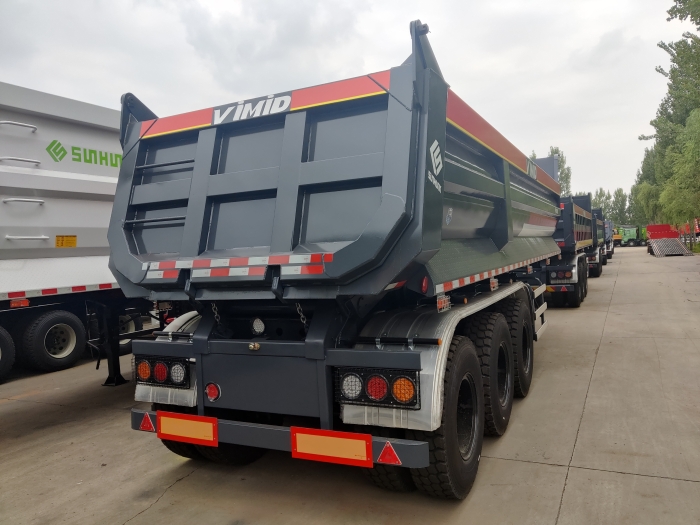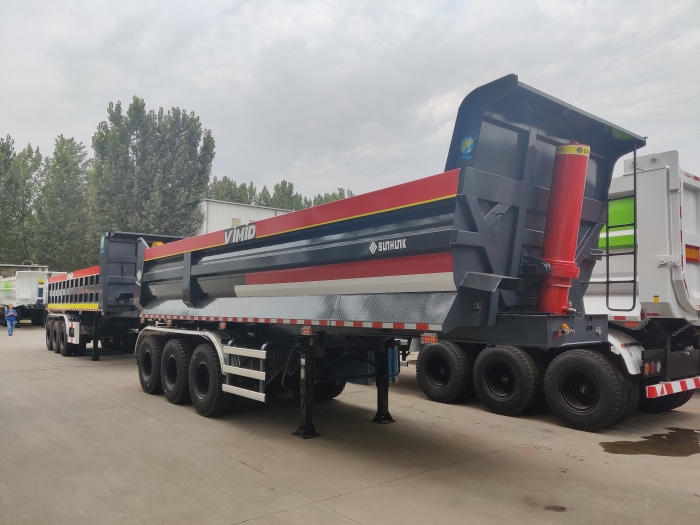- PRODUCTS
- SOLUTION
- SERVICE
- NEWS
- ABOUT US
Ensure even weight distribution, secure cargo with heavy-duty chains, use loading ramps carefully, check height, and double-check all tie-down points
Preparing a low bed semi-trailer for loading requires careful attention and precision. The process safeguards the safety and efficiency of the drive, as well as that of the cargo and the trailer. The most important steps of preparing semi-trailers for loading include:
The distribution of weight must be equal to the ensure, thus aiming at maintaining the trailer on the road without any risk of accidents or tipping. A low bed semi trailer can bear any cargo ranging from 20,000 to 80,000 pounds. Place the heavier items in the middle of the trailer on top of the axles. Failing to do so affects the balance and might lead to an unnecessarily strained suspension, or force higher pressure on the rear or front side. The latter might lead to tipping, while the former can strain the suspension.
Use heavy-duty load binders and chains. When loading machinery and oversized equipment, ensure that every piece of cargo has no less than four locations between which the chains attach as contact. The chains typically range from 3/8” to 5/8” in diameter and withstand up to 15,000 pounds of weight.
When using loading ramps, ensure they are safe and no risk of slippage or misalignment can occur. The former might lead to accidents, while the latter decreases efficiency. Ensure that the ramps are compatible with the specific weight of the cargo, allowing it easy access to semi-trailers. The available weight capacities are 10,000 pounds, 25,000 pounds, or even more. The fit must be secure for the items to cross securely.
The final step is gaining height clearance for bridges and overpasses along the way. The maximum legal height for bonded semi-trailers in most states varies between 13.5 and 14 feet. An oversized load permit can be gained on the interstate travel application website. Finally, use a measuring stick or a laser height gauge to ensure the measure is precise.
Transport a small distance and check tie-downs again. In time, when driving, the cargo settles and alters the initial force applied between the betters and the load. Regular subsequent inspections and adjustments are also advised, as driving over bumpy terrains or sharp curves can also lead to cargo displacement.

Loading a low bed semi-trailer is a very precise process involving several steps, all of which are critical for safety and stability. Here, I will outline the generally accepted procedure for loading a semi-trailer, focusing on critical actions and precautions to be taken.
Before anything, the trailer must be carefully inspected. Ensure no damage or wear exists on the trailer bed, the ramps, or the tie-down points. Ensure chains and binders, or any other needed equipment, are in good condition and properly rated for the cargo’s weight. Examine the trailer tires to ensure they are properly inflated and undamaged.
Make the trailer level with a stable surface, engage the trailer’s brakes, and chalk the wheels. Make sure the trailer will not go anywhere during the loading process. Any imbalance may lead to a very dangerous situation.
Make sure the ramps are properly aligned, and they should also be properly secured to the trailer. The ramp angle should not be too steep, and for most cargoes, the aforementioned angle of 15 to 20 degrees is generally deemed safe. Proper alignment is necessary to prevent the ramp from sliding at the crucial moment.
Drive or push the cargo up the ramp. For a vehicle or some heavy machinery, it should be driven at a slow but steady pace. To ensure the driver can properly place the load on the trailer’s bed, a spotter may be required. For non-motorized loads, use the winch or some other mechanical means to pull it onto the semi-trailer. Make sure the load is steady at all times, and no undue shocks are applied to the cargo or the trailer.
Once the load is placed, make sure it is secured. To properly tie down a load, use at least two heavy-duty chains and a binder for each. Place the chains at the extreme ends of the load or the trailer, if necessary. Each tie-down point must have a working load limit equal to or greater than the weight of the cargo. In most cases, four tie-downs will be necessary, but a larger cargo may require more. Always tighten the chains with the binders and ensure there is no slack in the chains.
Walk once more around the trailer and ensure each tie-down is secure. Make sure that the load isn’t moving anywhere and the ramps are properly stowed.
Before driving off, make sure your load isn’t too high or too heavy. In most states, the load height shouldn’t exceed 13.5-14feet. The total weight of the trailer, which is generally limited to 40 tons is also important. In most cases, you can use a weigh station before that, but if you don’t have time or the necessary one’s off your route, it’s best to plan your load’s weight in advance.
It is essential that cargo is properly fixed and reinforced on a low bed semi-trailer. This involves methods enabling the load not to move and the condition of the load and the trailer to be preserved.
Chains and binders must be chosen according to the weight of the cargo. Chains may vary from Grade 70 to Grade 120, with WLL ranging from 4,700 to 15,000. Binders must comply with chains in power. Using equip working inappropriate do can result in its failure and accidents.
Chains must be attached to specific anchor points on the trailer and the cargo. No less than four chains must be used for one of the cargos, they must also cross the load. Chains must be fixed by ratchet or lever binders. TBWS must not move more than an inch in any direction.
Extra reinforcement must be used for oversized or formless loads. Chains must be covered by edge protectors to avoid cutting down the load. For loads higher than 8 feet, overhead straps should be used in addition to chains. Overhead straps make the load stable in a vertical direction, and also they avoid tipping.
TBWS and load tightening must be checked regularly. After the first TBWS tightening, an extra piece of road must be driven and the TBWS must be viewed once more. Bolts must be thightened to no more than 300, or no more than 500 foot pounds, power suit be happen. Except this, chains can loosen and the cargo may slide, which might cause accidents.
Respectively, dunnage and blocks are pieces of wooden organ used between cargo items and to divide weight evenly and prevent its movements. They must be wooden and made out of hardwood, no less than 4*4 inches. The lid of the platform may be damaged without o dunnage, and the cargo may not sit well.

Ensuring the safety of the loading process of a lowbed semi-trailer is a distinctly critical task. It involves proper adherence to all safety concerns and utilizing the right equipment. Generally, the process of loading a semi-trailer refers to equipment need, preparation of the loading site, inspection of equipment, loading equipment, and technology, load security, training, and emergency procedures. Here are the major steps within the described categories.
The first and foremost step in the equipment safe loading scenario is wearing PPE. Particularly, the workers should wear hard hats, safety gloves, steel-toed boots, and high-visibility vests. This is the important measure that would reduce the effect and frequency of injury that might occur loading and handling.
It includes such steps as leveling the ground and making it free of rubbish. Second, it is marking the loading area and blocking it off with cones or bars. It ensures that no unauthorized personnel may be within the vicinity of danger and, thus, ensures the safe loading process.
Once the site is prepared, the equipment should be checked. Particularly, the ramp should not be cracked. Second, heating the chains and wires, and bonding equipment should not be damaged. Third, ramps existing should be appropriate for the equipment loaded. The failure or defectiveness of this equipment may lead to increased likelihood of load coming off or injuring the relevant personnel.
Spotters need to keep guides that make sure they communicate and direct the driver through the signs they know. Alternatively, mobile workers can employ radio communication with the driver. Dozen of accidents are thus prevented. Make sure the load does not shift from left to right, and it does not move ahead over the truck. Second, use an asymmetric load for expertise. If using a bulldozer, ensure all other moving parts are fastened and removed.
This goes in hands with the previous step. Thus, the right number of chains and wires are used, and they are appropriately bonded. Alternatively, a strap-down can be used. Second, the machinery is frequently kept heavy, meaning it is imperative that all moving parts are entirely and safely fastened or separated. This is important as failure in machinery fastening may lead to the load coming off.
A variety of technologies may be used. First, some load sensors may be mounted that would generate data about the respective load and ensure it is properly loaded, that is, asymmetrically. Second, cameras can be used in this case. They may increase the site viewing number by two times and reduce the incidence of a blind spot. They cannot be replaced by sensor teams. Third, range sensors can be safely used.
It is imperative that all workers present at the site should receive total training on the described load procedures. This will relate to the machinery employed, communication with other workers and, critically, the sign made every spotter expects the driver to know.
The workers should know what to do in case of any accident, either a load shift, or any equipment failure. That is, a clearly formulated action plan should exist, and the workers should know it. Forming such may be particularly important down to a vocal level every three months.